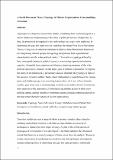Files in this item
A social movement theory typology of militant organisations : contextualising terrorism
Item metadata
| dc.contributor.author | Marsden, Sarah Victoria | |
| dc.date.accessioned | 2016-03-31T23:01:29Z | |
| dc.date.available | 2016-03-31T23:01:29Z | |
| dc.date.issued | 2015 | |
| dc.identifier | 164170801 | |
| dc.identifier | d09efa6f-169d-4f9b-b255-3a25d1275950 | |
| dc.identifier | 84907802877 | |
| dc.identifier | 000383898100006 | |
| dc.identifier.citation | Marsden , S V 2015 , ' A social movement theory typology of militant organisations : contextualising terrorism ' , Terrorism and Political Violence . https://doi.org/10.1080/09546553.2014.954039 | en |
| dc.identifier.issn | 0954-6553 | |
| dc.identifier.other | ORCID: /0000-0002-4763-5068/work/80257714 | |
| dc.identifier.uri | https://hdl.handle.net/10023/8528 | |
| dc.description | Date of acceptance 8/8/14 | en |
| dc.description.abstract | Typologies are ubiquitous in terrorism studies, illustrating their continued appeal as a tool to further our understanding of this form of political violence. Despite this, to date, the promise of an empirically derived typology has largely been neglected. In addressing this gap, this article sets out a typology developed from Social Movement Theory. Using a novel statistical technique to derive a three-dimensional framework for categorising militant groups, the typology incorporates both organisational characteristics and the wider political context. The result is a typology defined by three conceptual constructs: political capacity, war-making capacity, and network capacity. Alongside these organisational features, imposing measures of the wider political opportunity structure reveals eight types of militant organisation. To explore the utility of the framework, a preliminary analysis interprets the typology in light of the presence of wider conflict. That a robust relationship is found between the various types and whether groups were operating in peacetime, civil war, or low-intensity conflict, goes some way to demonstrating its utility as an analytical tool. Conclusions draw attention to the importance of contextualising militant groups in their socio-political setting, and the benefits of combining theory alongside empirical analysis to develop robust characterisations of violent organisations. | |
| dc.format.extent | 588121 | |
| dc.language.iso | eng | |
| dc.relation.ispartof | Terrorism and Political Violence | en |
| dc.rights | Copyright Taylor & Francis Group, LLC. This is an Accepted Manuscript of an article published by Taylor & Francis in Terrorism and Political Violence on 01/10/2014, available online: http://wwww.tandfonline.com/10.1080/09546553.2014.954039 | en |
| dc.subject | Typology | en |
| dc.subject | Social Movement Theory | en |
| dc.subject | Multidimensional Partial Order Scalogram by Coordinates | en |
| dc.subject | Mixed methods | en |
| dc.subject | Conceptualising militant groups | en |
| dc.subject | JZ International relations | en |
| dc.subject | SDG 16 - Peace, Justice and Strong Institutions | en |
| dc.subject.lcc | JZ | en |
| dc.title | A social movement theory typology of militant organisations : contextualising terrorism | en |
| dc.type | Journal article | en |
| dc.contributor.institution | University of St Andrews.School of International Relations | en |
| dc.contributor.institution | University of St Andrews.The Handa Centre for the Study of Terrorism and Political Violence | en |
| dc.identifier.doi | 10.1080/09546553.2014.954039 | |
| dc.description.status | Peer reviewed | en |
| dc.date.embargoedUntil | 2016-04-01 |
This item appears in the following Collection(s)
Items in the St Andrews Research Repository are protected by copyright, with all rights reserved, unless otherwise indicated.

